Chapmannia floridana
| Chapmannia floridana | |
|---|---|

| |
| Photo by Wayne Matchett, SpaceCoastWildflowers.com | |
| Scientific classification | |
| Kingdom: | Plantae |
| Division: | Magnoliophyta - Flowering plants |
| Class: | Magnoliopsida - Dicotyledons |
| Order: | Fabales |
| Family: | Fabaceae ⁄ Leguminosae |
| Genus: | Chapmannia |
| Species: | C. floridana |
| Binomial name | |
| Chapmannia floridana Torr. & A. Gray | |

| |
| Natural range of Chapmannia floridana from USDA NRCS Plants Database. | |
Common name: Florida alicia
Contents
Taxonomic notes
Synonyms: none.[1]
Varieties: none.[1]
Description
Chapmannia floridana is an erect perennial herb arising from a fleshy tap root and can reach three feet in height.[2] All parts of the plant are covered with sticky hairs and leaves are alternately arranged.[3] It is a nitrogen fixer.[4]The fruits are latitudinally segmented pods with one seed in each segment. The seeds are covered with grandular trichomes that may protect against seed predation and aid in seed dispersal.[5]
The root system of C. floridana includes stem tubers which store non-structural carbohydrates (NSC) important for both resprouting following fire and persisting during long periods of fire exclusion.[6] Diaz-Toribio and Putz (2021) recorded this species to have an NSC concentration of 155.5 mg/g (ranking 35 out of 100 species studied) and water content of 44.6% (ranking 23 out of 100 species studied).[6]
According to Diaz-Torbio and Putz (2021), Chapmannia floridana has stem tubers with a below-ground to above-ground biomass ratio of 1.125 and nonstructural carbohydrate concentration of 155.5 mg g-1.[7]
Distribution
The Chapmannia genera is endemic to the longleaf pine range from southeastern Virginia to central Florida and west to southeast Texas.[8] C. floridana is endemic to Florida.[3]
Ecology
Habitat
In the Coastal Plain in Florida, C. floridana has been found in turkey oak/longleaf pine sand ridges; pine-palmettos flatwoods; longleaf pine-wiregrass ridges; and scrub oak sand ridges. It is found in large populations in highly disturbed areas compared to undisturbed areas, making it unusual from other Florida endemic scrub species which are sensitive to disturbance[4]. Populations have been found in disturbed areas such as heavily cattle grazed longleaf pine-saw palmetto flatwoods, roadsides, and pastures.[4][9]
Phenology
Flowers are yellow and orange and are composed of three petals.[3] C. floridana has been observed flowering April through August and fruiting in May.[9][10]
Fire ecology
Carrington (1999) found C. floridana to be a strong re-sprouter after fire, however it did not show a strong flowering response.[11] Seedlings were only present for five months post-fire, suggesting a weak seedling establishment after fire.[11] Populations have been observed to be low in undisturbed, burned areas.[4]
Pollination
Bombus impatiens and Augochloropsis are the major visitors to C. floridana. They have been observed ripping holes in the sides of the keel petals of the flower and vibrating their wings to get pollen out of the floral tube. Pollinators visitation rates are affected by temperature, flower size, and flowering density.[4] C. floridana has been observed at the Archbold Biological Station to host bees such as Bombus impatiens (family Apidae) and sweat bees from the Halictidae family such as Augochlorella aurata, Augochloropsis metallica, Lasioglossum nymphalis and L. placidensis.[12]
Conservation, cultivation, and restoration
Global status rank: G5 secure [13].
Cultural use
Photo Gallery
References and notes
- ↑ 1.0 1.1 Weakley, A.S. 2015. Flora of the southern and mid-atlantic states. Working Draft of 21 May 2015. University of North Carolina at Chapel Hill, Chapel Hill, North Carolina.
- ↑ Gunn, Charles R., Eliane M. Norman, and J. Stuart Lassetter. “Chapmannia Floridana Torrey & Gray (fabaceae)”. Brittonia 32.2 (1980): 178–185.
- ↑ 3.0 3.1 3.2 [Native Florida Wildflowers]Accessed: December 4, 2015
- ↑ 4.0 4.1 4.2 4.3 4.4 Mayfield, Margaret M.. “Pollinators of Chapmannia Floridana (fabaceae) and Their Foraging Preferences”. The Florida Entomologist 81.4 (1998): 489–496.
- ↑ Schafer J. 2017. Tricks of the trade: characteristics of Florida Alicia that facilitate its persistence in Florida habitats. Palmetto 34(1):8-11.
- ↑ 6.0 6.1 Diaz-Toribio, M.H. and F. E. Putz 2021. Underground carbohydrate stores and storage organs in fire-maintained longleaf pine savannas in Florida, USA. American Journal of Botany 108: 432-442.
- ↑ Diaz‐Toribio, M. H. and F. E. Putz. 2021. Underground carbohydrate stores and storage organs in fire‐maintained longleaf pine savannas in Florida, USA. American Journal of Botany 108(3):432-442.
- ↑ Sorrie, B. A. and A. S. Weakley 2001. Coastal Plain valcular plant endemics: Phytogeographic patterns. Castanea 66: 50-82.
- ↑ 9.0 9.1 Florida State University Robert K. Godfrey Herbarium database. URL: http://herbarium.bio.fsu.edu. Last accessed: October 2015. Collectors: Loran C. Anderson, J. Beckner, D. Burch, J. Carmichael, A. Gholson Jr., R.K. Godfrey, Richard D. Houk, R. Kral, K.M. Meyer, Allen G. Shuey, A. Townesmith, D.B. Ward. States and Counties: Florida: Clay, DeSoto, Glades, Lake, Marion, Orange, Osceola, Polk, Seminole. Compiled by Tall Timbers Research Station and Land Conservancy.
- ↑ Nelson, G. PanFlora: Plant data for the eastern United States with emphasis on the Southeastern Coastal Plains, Florida, and the Florida Panhandle. www.gilnelson.com/PanFlora/ Accessed: 7 DEC 2016
- ↑ 11.0 11.1 Carrington, M. E. (1999). "Post-fire seedling establishment in Florida sand pine scrub." Journal of Vegetation Science 10(3): 403-412.
- ↑ Deyrup, M.A. and N.D. 2015. Database of observations of Hymenoptera visitations to flowers of plants on Archbold Biological Station, Florida, USA.
- ↑ [Encyclopedia of Life] Accessed December 4, 2015